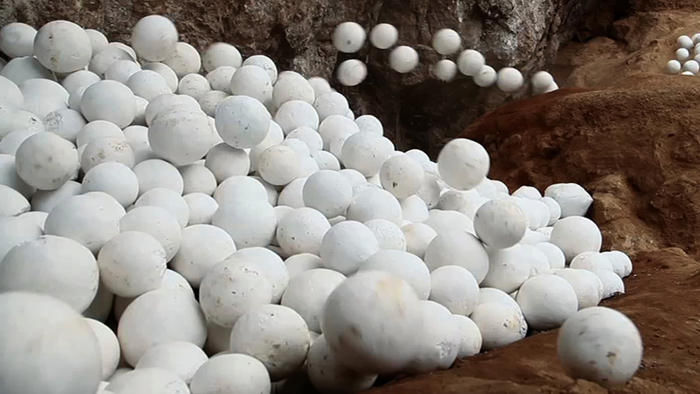Press Release
UCCA Dune presents Land of the Lustrous, encompassing work by ten artists both in and beyond China. Each artwork in this exhibition relates—materially or formally—to the figure of the stone, approaching this age-

Land of the Lustrous
UCCA Dune, Beijing (China)
23.04 - 08.09.2019

Artworks in Land of the Lustrous serve as explorations of a single animist belief: that rock, a piece of seemingly inert matter, is actually endowed with life and thought. Wang Sishun’s Apocalypse 16.9.1, for example, personifies three found stones; arrayed in a line, they stand rigidly upright in cautious dialogue. Zhao Yao, Lin Xue, and Miguel Angel Ríos, similarly, have selected stones of unassuming appearance and brought them to life by cleverly manipulating their details, positions, and “postures”: Zhao Yao has placed an enormous red Mani stone on the edge of the sea; Lin Xue has drawn a series of fruit pits, transforming them into heavenly bodies. Ríos’s film records a cascade of tumbling stones, recalling the vigorous movements of antelope.
The proposition that stone “is alive” results in several ancillary questions—is humankind the measure of the universe? Is it shortsighted to base values solely on our limited ways of understanding the world? As urbanization and modernization progress, will such nearsighted forms of knowledge bring about a corresponding rise in alienation? After all, only humans can consume, produce, and create surplus value in the world of capital, wherein “nature” serves solely as dead material. Timur Si-
Other artists use these mysterious, self-
The exhibition also provides a series of myths related to stone, forming an interpretive framework for the artworks. These visual misreadings closely resemble the oral transmission—and mutation—of myths. In this exhibition, a discourse based on precedent and change links to a more capacious visual system, an interchange that depends less on precision than on inspiration. “Land of the Lustrous” hopes to uncover and awaken several possibilities often overlooked in the context of contemporary art. China has a long, fruitful history of worshiping stone deities; this most ordinary of objects has gained an aura of ineffability in popular consciousness. This aura suffuses the artworks, too, circumventing that anxiety plaguing Wittgenstein as he described “pictures placed in language.”
Exhibition April 23, September 8, 2019. UCCA, Beijing, 798 Art District, No. 4 Jiuxianqiao Road, Chaoyang District. 100015 Beijing (China). T +86 10 5780 0200. Hours: Monday–Sunday 10am–7pm.
Miguel Angel Ríos, Piedras Blancas, 2019. Video, dimensions variable. Courtesy the artist


© ArtCatalyse International / Marika Prévosto 2019. All Rights Reserved